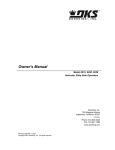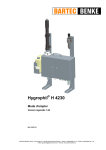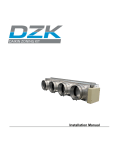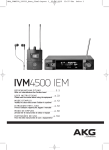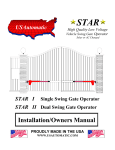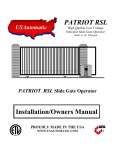Download DKS 1150 Installation guide
Transcript
1150 overhead gate operator ● installation guide installation guide overhead gate operator DKS DoorKing, Inc. 120 Glasgow, Avenue Inglewood, Ca. 90301 310.645.0023 310.641.1586 fax www.doorking.com [email protected] Copyright © 2007 DoorKing, Inc. All rights reserved. notice of rights The content in this manual is protected under copyright law and no portion of this manual may be copied, reproduced, translated, or converted to any electronic medium without prior written consent. notice of liability DoorKing, Inc. reserves the right to make changes in the products described in this manual without notice and/or obligation to notify any persons of any revisions or changes. DoorKing, Inc. makes no representations or warranties with respect to this manual. publication number general information safety information .....................................................................................................4 glossary ........................................................................................................................6 specifications ..............................................................................................................7 hardware installation rail ..................................................................................................................................8 operator .......................................................................................................................9 alternate mounting ..................................................................................................10 gate arm ......................................................................................................................11 manual release ..........................................................................................................12 power switch .............................................................................................................13 electrical installation main terminal description .....................................................................................14 wiring diagram ..........................................................................................................15 high voltage ...............................................................................................................16 control wiring ............................................................................................................17 entrapment protection ...........................................................................................18 loop detector .............................................................................................................20 gate tracker ................................................................................................................21 auxiliary stop .............................................................................................................22 settings control board .............................................................................................................23 DIP-switches ..............................................................................................................24 limits ............................................................................................................................25 inherent reverse ........................................................................................................26 technical information maintenance schedule ............................................................................................27 troubleshooting ........................................................................................................28 accessories .................................................................................................................29 save this installation guide for reference 1150-065-B-05-07 general information/safety information Important Notice Vehicular gate operator products provide convenience and security. However, gate operators must use high levels of force to move gates and most people underestimate the power of these systems and do not realize the potential hazards associated with an incorrectly designed or installed system. These hazards may include: Pinch points Entrapment areas Reach through hazards Absence of entrapment protection devices Improperly located access controls Absence of vehicle protection devices Absence of controlled pedestrian access In addition to these potential hazards, automated vehicular gate systems must be installed in accordance with the UL-325 Safety Standard and the ASTM F2200 Construction Standard. Most people are unaware of, or are not familiar with, these standards. If an automated vehicular gate system is not properly designed, installed, used and maintained, serious injuries or death can result. Be sure that the installer has instructed you on the proper operation of the gate and gate operator system. Be sure that the installer has trained you about the basic functions of the required reversing systems associated with your gate operating system and how to test them. These include reversing loops, inherent reversing system, electric edges, photoelectric cells, or other external devices. This Owner’s Manual is your property. Keep it in a safe place for future reference. Be sure that all access control devices are installed a minimum distance of 10 feet away from the gate and gate operator, or in such a way that a person cannot touch the gate or gate operator while using the device. If access control devices are installed in violation of these restrictions, immediately remove the gate operator from service and contact your installing dealer. Loops and loop detectors, photo-cells or other equivalent devices must be installed to prevent the gate from closing on vehicular traffic. 4 installation guide The speed limit for vehicular traffic through the gate area is 5 MPH. Install speed bumps and signs to keep vehicular traffic from speeding through the gate area. Failure to adhere to posted speed limits can result in damage to the gate, gate operator, and to the vehicle. Be sure that all persons who use the gate system are familiar with the proper use of the gate and gate operator and are familiar with the possible hazards associated with the gate system. Be sure that warning signs are permanently installed on both sides of the gate in an area where they are fully visible to traffic. It is your responsibility to periodically check all entrapment protection devices. If any of these devices are observed to function improperly, remove the operator from service immediately and contact your installing or servicing dealer. Follow the recommended maintenance schedule. Do not allow children to play in the area of the operator or to play with any gateoperating device To remove the gate operator from service, operate the gate to the full open position and then shut off power to the operator at the service panel. Important Safety Instructions WARNING - To reduce the risk of injury or death read and follow all instructions: 1. Never let children operate or play with gate controls. Keep the remote control away from children. 2. Always keep people and objects away from gate. NO ONE SHOULD CROSS THE PATH OF THE MOVING GATE. 3. Test the operator monthly. The gate MUST reverse on contact (contact sensors must be installed) with a rigid object or stop or reverse when an object activates the non-contact sensors. After adjusting the force or the limit of travel, retest the gate operator. Failure to adjust and retest the gate operator properly can increase the risk of injury or death. 4. Use the emergency release only when the gate is not moving. 5. KEEP GATES PROPERLY MAINTAINED. Read the owner’s manual. Have a qualified service person make repairs to gate hardware. 6. The entrance is for vehicles only. Pedestrians must use separate entrance. 7. Save these Instruction for future reference 1150-065-B-05-07 general information/safety information Gate Construction Vehicular gates should be constructed and installed in accordance with ASTM F2200; Standard Specification for Automated Vehicular Gate Construction. For a copy of this standard, contact ASTM directly at 610-832-9585; [email protected]; or www.astm.org. Instructions for Intended Installation Install the gate operator only if: 1. The operator is appropriate for the construction of the gate and the usage class of the gate. 2. All openings of a horizontal slide gate are guarded or screened from the bottom of the gate to a minimum of 4 feet (1.22 m) above the ground to prevent a 2 ¼ inch (57.2 mm) diameter sphere from passing through the openings anywhere in the gate, and in that portion of the adjacent fence that the gate covers in the open position. 3. 4. All exposed pinch points are eliminated or guarded. Controls intended for user activation must be located at least ten feet (10’) away from any moving part of the gate and where the user is prevented from reaching over, under, around or through the gate to operate the controls. Outdoor or easily accessible controls should have a security feature to prevent unauthorized use. The Stop and/or Reset button must be located in the line-of-sight of the gate. Activation of the reset control shall not cause the operator to start. A minimum of two (2) WARNING SIGNS shall be installed, one on each side of the gate where easily visible. For gate operators utilizing a non-contact sensor: 1. See the instructions on the placement of non-contact sensors for each type of application. 2. Care shall be exercised to reduce the risk of nuisance tripping, such as when a vehicle trips the sensor while the gate is still moving in the opening direction. 3. One or more non-contact sensors shall be located where the risk of entrapment or obstruction exist, such as the perimeter reachable by a moving gate or barrier. Guarding is supplied for exposed rollers. The operator is intended for installation only on gates used for vehicles. Pedestrians must be supplied with a separate access opening. The pedestrian access opening shall be designed to promote pedestrian usage. Locate the gate such that persons will not come in contact with the vehicular gate during the entire path of travel of the vehicular gate. The gate must be installed in a location so that enough clearance is supplied between the gate and adjacent structures when opening and closing to reduce the risk of entrapment. Swinging gates should not open into public access areas. The gate must be properly installed and work freely in both directions prior to the installation of the gate operator. Do not over-tighten the operator clutch, pressure relief valve or reduce reversing sensitivity to compensate for a damaged gate. For gate operators utilizing contact sensors: 1. One or more contact sensors shall be located where the risk of entrapment or obstruction exist, such as at the leading edge, trailing edge, and post mounted both inside and outside of a vehicular horizontal slide gate. 2. One or more contact sensors shall be located at the bottom edge of a vehicular vertical lift gate. 3. One or more contact sensors shall be located at the pinch point of a vehicular vertical pivot gate. 4. A hardwired contact sensor shall be located and its wiring arranged so that the communication between the sensor and the gate operator is not subjected to mechanical damage. 5. A wireless contact sensor such as one that transmits radio frequency (RF) signals to the gate operator for entrapment protection functions shall be located where the transmission of the signals are not obstructed or impeded by building structures, natural landscaping or similar obstructions. A wireless contact sensor shall function under the intended end-use conditions. 6. One or more contact sensors shall be located at the bottom edge of a vertical barrier (arm). For gate operators utilizing Type D protection: 1150-065-B-05-07 1. The gate operator controls must be placed so that the user has full view of the gate area when the gate is moving. 2. A warning placard shall be placed adjacent to the controls. 3. An automatic closing device (such as a timer, loop sensor, or similar device) shall not be used. 4. No other activation device shall be connected. installation guide 5 general information/glossary GATE – A moving barrier such as a swinging, sliding, raising, lowering, or the like, barrier, that is a stand-alone passage barrier or is that portion of a wall or fence system that controls entrance and/or egress by persons or vehicles and completes the perimeter of a defined area. RESIDENTIAL VEHICULAR OPERATOR-CLASS – A vehicular gate operator (or system) intended for use in a home of one-to four single family dwelling, or garage or parking area associated therewith. COMMERCIAL / GENERAL ACCESS VEHICULAR OPERATOR-CLASS II – A vehicular gate operator (or system) intended for use in a commercial location or building such as a multi-family housing unit (five or more single family units), hotels, garages, retail store, or other building servicing the general public. INDUSTRIAL / LIMITED ACCESS VEHICULAR OPERATOR-CLASS III – A vehicular gate operator (or system) intended for use in an industrial location or building such as a factory or loading dock area or other locations not intended to service the general public. RESTRICTED ACCESS VEHICULAR OPERATOR-CLASS IV – A vehicular gate operator (or system) intended for use in a guarded industrial location or building such as an airport security area or other restricted access locations not servicing the general public, in which unauthorized access is prevented via supervision by security personnel. VEHICULAR BARRIER (ARM) OPERATOR (OR SYSTEM) – An operator (or system) that controls a cantilever type device (or system), consisting of a mechanical arm or barrier that moves in a vertical arc, intended for vehicular traffic flow at entrances or exits to areas such as parking garages, lots or toll areas. VEHICULAR HORIZONTAL SLIDE-GATE OPERATOR (OR SYSTEM) – A vehicular gate operator (or system) that controls a gate which slides in a horizontal direction that is intended for use for vehicular entrance and exit to a drive, parking lot, or the like. VEHICULAR SWING-GATE OPERATOR (OR SYSTEM) – A vehicular gate operator (or system) that controls a gate which moves in an arc in a horizontal plane that is intended for use for vehicular entrance and exit to a drive, parking lot, or the like. SYSTEM – In the context of these requirements, a system refers to a group of interacting devices intended to perform a common function. WIRED CONTROL – A control implemented in a form of fixed physical interconnections between the control, the associated devices, and an operator to perform predetermined functions in response to input signals. WIRELESS CONTROL – A control implemented in means other than fixed physical interconnections (such as radio waves or infrared beams) between the control, the associated devices, and an operator to perform predetermined functions in response to input signals. INHERENT ENTRAPMENT SENSOR SYSTEM – An automatic sensor system that senses entrapment of a solid object and is incorporated as a permanent and integral part of the operator. EXTERNAL ENTRAPMENT PROTECTION DEVICE – A device, examples being an edge sensor, a photoelectric sensor, or similar entrapment protection device, which provides protection against entrapment when activated and is not incorporated as a permanent part of an operator. ENTRAPMENT – The condition when an object is caught or held in a position that increases the risk of injury. 6 installation guide 1150-065-B-05-07 general information/specifications operator The 1150 overhead gate operator is designed for high traffic underground parking applications serving gated communities, apartment complexes, commercial buildings and industrial sites. This operator is not designed for residential applications and should never be used to operate overhead sectional garage doors. class: II, III, IV horsepower: 1/2 HP continuos duty 115 VAC, 60 Hz, 5.4A gate limitations: max gate height up to 14 Ft max gate width 25-feet* *Assumes gate is in good condition with properly adjusted hardware. mechanical: 40:1 worm gear running in a continuous oil bath chain #40 speed: Approximately 10 in/sec (254 mm/sec) cover: Charcoal grey polyethylene frame: G90 Galvanized steel to prevent rusting. ! manual release: fail-secure mechanical advanced features Fail-secure, keyed quick release Shock mounts Easy to use chain adjust Programming switches Built-in power On/Off switch Direct driven limit nuts for precise gate control Auto-close timer 1-23 sec Ports for plug-in open and reverse loop detectors (DKS detectors only). Timer override feature helps prevent tailgating operation temp: 10ºF to 140ºF -12ºC to 62ºC Rail P/N MAX GATE Ht. DIM. A 1150-120 8’ feet 12’ ft - 5” in 1150-121 10’ feet 14’ ft - 5” in 1150-122 12’ feet 16’ ft - 5” in 1150-123 14’ feet 18’ ft - 5” in safety Listing: Complies with UL 325 and UL 991 safety standards. ETL Listed dimenisions: Surface Mount 15”W x 4” H x 15.5D Transfer box provides a mounting platform and links the operator to the spike unit. warranty: 5-year limited factory warranty 1150-065-B-05-07 installation guide 7 hardware installation/rail 1 Attach and secure the rail to the operator assembly using the appropriate hardware. 2 Cut the wire tie and route the chain around the sprocket and attach the chain to the other end using the double master link. MASTER LINK Chain and sprocket must be centered between the rail assembly. CHAIN ADJUST 3 Locate the chain adjustment bolts on the rail assembly and make the necessary adjustments. Do not over-tighten the chain. Make chain adjustments equally on both sides of the rail assembly. CHAIN 8 installation guide 1150-065-B-05-07 hardware installation/operator 1 Install the Gate Bracket to the top center rail of the gate by bolting or welding. 2 Loosen the Header Bracket and Rails, allowing the Header Bracket to rotate freely. 3 Center the Header Bracket with the Gate Bracket, a minimum clearance of 2.5 inches is required from the top of the gate bracket to the bottom of the header bracket. 4 Secure the rail assembly/header bracket to the header by bolting or welding. 5 Raise the operator and rest it on a stepladder, or use a rope and tie it to the ceiling. The operator and rail assembly should be leveled. 6 Manually raise and lower the gate, correct any interference if needed. 7 Secure and tighten all mounting bolts, including the header bracket bolt. 8 Check oil level, add Mobil oil SHC-624 or equivalent and install breather cap. IMPORTANT: Do not fill gearbox to top, gearbox should be half full only. RAIL/BRACKET ASSEMBLY 4 3 &&/ ./ 2 HEADER BRACKET M 1 IN GATE BRACKET 5 8 1150-065-B-05-07 BREATHER CAP installation guide 9 hardware installation/alternate mounting ALTERNATE HEADER BRACKET INSTALLATION Mount the header bracket directly to the ceiling of the underground parking area. Isolate the header bracket from the ceiling using rubber shock mounts. ALTERNATE OPERATOR BRACKET INSTALLATION DOORKING does not provide the ceiling extension bracket, it must be fabricated according to building requiremnets. Isolate the bracket from the ceiling using rubber shock mounts Check all local building codes and ordinances to ensure compliance. 10 installation guide 1150-065-B-05-07 hardware installation/gate arm 1 Insert the manual release key and unlock carriage assembly from the drive chain, pull the release ring and rotate 1/4 clockwise, allowing the carriage to slide freely. 2 Attach the arm assembly to the gate bracket and carriage assembly as shown. 3 Manually raise and lower the gate, be sure the gate is operating smoothly and is not binding anywhere. Any interference must be corrected now. 1 2 PULL DOWN AND TURN COUNTER CLOCK-WISE 1150-065-B-05-07 installation guide 11 hardware installation/manual release This operator is equipped with a manual release system that will allow the gate to be opened in the event of a power outage or equipment failure. Never attempt to manually push open any gate with an operator attached to it until you have verified that power to the operator has been shut-off. 1 Turn off the primary (AC) power or turn off using the shut-down switch before placing the gate operator in manual operation. 2 Insert the manual release key and unlock carriage from the drive chain, pull the release ring and rotate 1/4 clockwise, allowing the carriage to slide freely. 3 Gate can now be manually opened and closed. 4 To lock the carriage assembly for automatic operation, slide the carriage below the master link until you hear a loud click. Slide the the ring back in to place and lock the the carriage. Master Link 2 12 installation guide Carriage 1150-065-B-05-07 hardware installation/power switch The operator ON or OFF power switch is located on the back of the operator. 1150-065-B-05-07 ON OFF installation guide 13 electrical installation/main terminal description 1. LOW VOLTAGE COMMON 2. FULL OPEN / CLOSE INPUT When gate is closed, input will open gate to full position. When gate is open and auto close timer is turned on, input will re-set and hold timer. When gate is open and auto close timer is turned off, input will close gate. When gate is closing, input will reverse gate. 3. NOT USED 4. EXIT LOOP LOGIC OUTPUT - If SW 1, switch 3 is OFF, this terminal becomes the logic output of the loop detector plugged into the EXIT loop port (DoorKing loop detectors only). 5. NOT USED 6. NOT USED 7. STANDARD REVERSE / STOP INPUT When gate is fully closed or in the opening cycle, this input has no affect on the gate operator. When gate is open and auto close timer is turned ON, input will re-set and hold timer. When gate is open and auto close timer is turned OFF, input will prevent gate from closing. When gate is closing, input will REVERSE gate if SW 1, switch 7 is OFF. When gate is closing, input will STOP gate if SW 1, switch 7 is ON. 8. OPEN INPUT - Use with DoorKing 3 button control station only (P/N 1200-006). 11. GATE TRACKER - BUSY 12. DRY RELAY CONTACT - Operation of relay is dependent on setting of SW 1, switches 4 and 5. Relay contacts can be set for Normally Open (NO) or Normally Closed (NC) operation. Contact rating is 1 amp maximum at 24 Volts. 13. DRY RELAY CONTACT 14. 24 VAC, 250 MA MAXIMUM 15. NOT USED 16. POWER OUTPUT TO MOTOR 17. POWER OUTPUT TO MOTOR 18. 120 VAC HOT 19. 120 VAC NEUTRAL 20. EARTH GROUND / CHASSIS 14 installation guide NOTE: 10. GATE TRACKER - DATA See page 24 for switch settings and options. DC power is not present on the board until the first initial cycle. 9. CLOSE INPUT - Use with DoorKing 3 button control station only (P/N 1200-006). 1150-065-B-05-07 electrical installation/wiring diagram P1 3&% #-6& 8)*5& .0503 108&3 #-"$, #-"$, 0/0'' 8)*5& /&653"- (3&&/ (306/% $-04& $0. 01&/ $0. /0 /$ P2 #-6& /0 /$ :&--08 8)*5& 8)*5& 1150-065-B-05-07 7"$)05 installation guide 15 electrical installation/high voltage MODEL AMPS 1150-08X 5.4 WIRE SIZE / DISTANCE IN FEET 12 AWG 10 AWG 8 AWG 6 AWG 170 275 460 685 The distance shown above is measured in feet from the operator to the power source. If power wiring is greater than the maximum distance shown, it is recommended that a service feeder be installed. When large gauge wire is used, a separate junction box must be installed for the operator connection. The wire table is based on stranded copper wire. Wire run calculations are based on a 3% voltage drop on the power line, plus an additional 10% reduction in distance to allow for other losses in the system. All wiring must comply with local code requirements. To protect against surges and power fluctuations it is recommended that a surge suppresser be installed on the high voltage power lines. The conduit requirements shown are for a typical overhead gate operator installation. The conduit requirements for your application may vary from this depending on your specific needs. Use only sweeps for conduit bends. Do not use 90° connectors as this will make wire pulls very difficult and may damage wire insulation. The control panel has knockouts to accommodate up to three (3) ½-inch conduits. Before attempting to connect any wiring to the operator, be sure that the circuit breaker in the electrical panel is in the OFF position. It is recommended that work be performed by a licensed electrical contractor. 1 From the High-Voltage conduit, route the wiring cable up to the terminal block. 2 Connect the High-Voltage wiring to the terminal block as shown. 1 ()'(6/,4!'% 7)2).'#/.$5)4 2 '2%%.'.$ 7()4%.%542!, ",!#+(/4 16 installation guide 1150-065-B-05-07 electrical installation/control wiring 1 Connect control devices to the operator terminal strip as shown. 2 Accessory items; card readers or keypads must be powered from their own power transformer. 2 1 Lock Boxes Key Switch '*3& %&15 Common Full Open Not Used Exit Loop Not Used Not Used Standard Reverse 3 Button Open Only Radio Receiver 24 VAC Power Digital Keypad Card Reader DOWN Photocell /0%. #,/3% 3 Button Close Only Push Button Telephone Entry 34/0 s#OMMON s2ELAY s2ADIO0OWER Stop MicroPLUS RF Receiver Controls must be far enough from the barrier operator, preventing contact with the operator/arm while operating the controls. Outdoor or easily accessible controls should have a security feature to prevent unauthorized use. Do not power any devices from the circuit board other than a low voltage radio receiver. Connect optional control devices to the main terminal strip. Use 18 AWG wire for all low voltage wiring, maximum distance 3000 feet. Use a low voltage surge suppressor, (DoorKing P/N 1878-010) if low voltage wire runs exceed 1000 feet. All inputs to the terminal strip must be NORMALLY OPEN. 1150-065-B-05-07 installation guide 17 electrical installation/entrapment protection This operator is equipped with an inherent (Type A) entrapment sensing system. The operator will sense an obstruction while opening or closing causing the gate to stop (open cycle) or reverse (close cycle) direction. Secondary entrapment prevention devices must be installed to insure a safe operating environment and reduce the risk of personnel entrapment or injury. Secondary entrapment prevention may be provided by a combination of both type sensors, see accessories for entrapment prevention devices. Use only UL listed (or equivalent) sensors. Non-Contact/Contact Sensors must be installed individually or in combination with each other to provide entrapment prevention. Reduce the risk of nuisance tripping, such as when a vehicle trips the sensor while the gate is still moving. Position sensors where the risk of entrapment or obstruction exists, such as the perimeter reachable by a moving gate or barrier. NON-CONTACT SENSOR 1 Disconnect power to the operator before installing sensors. 2 See illustration for suggested placement of sensors. (actual placement of sensors dependens on the installation requirements). Position photo-cell so that an entrapment cannot occur at the lower travel of the gate. Do not place the photo-cell so high that a person could be trapped under the gate without activating the photo-cell. 3 Connect the sensors to the main terminal strip, inputs from photo-beam to circuit board are NORMALLY OPEN. Photo-cell power wiring is not shown, refer to the wiring instructions included with hardware (sensors may require seperate power depending on model used). If high bed vehicles access the gate, a second photo-cell should be placed so that the photo-beam cannot scan under the vehicle. Photocell Receiover/Reflector Photocell Sender 1 18 installation guide Standard Reverse Common 2 1150-065-B-05-07 electrical installation/entrapment protection CONTACT SENSOR 1 Disconnect power to the operator before installing sensors. 2 Install the contact sensors at the bottom edge of the gate. Additional contact sensors may be added for additional protection where entrapment zones exist. 3 Route the edge connector wire into the junction box (see illustration). Avoid any interference with gate hardware. 4 Connect the sensors to the main terminal strip, sensing edge to circuit board is NORMALLY OPEN. Sensing edge installation is not shown, refer to hardware instructions included with hardware. Position and wire sensors avoiding communication loss and mechanical damage. See page 26 for sensor adjustment. 3 Junction Box 4 Standard Reverse Common 1150-065-B-05-07 2 Edge Sensor installation guide 19 electrical installation/loop detector If non-contact sensors are not used, loops and loop detectors must be installed to prevent the gate from accidentally closing on vehicles that may be in the path of the gate. 1 See illustration when installing Plug-In loop detector 9406-010. If other loop detectors are used, refer to the installation instructions included with detector. 2 Layout is for a typical overhead gate application with two-way traffic or one-way exit only. For one-way entry only, the open loop and loop detector are not needed. 3 Reverse loops are wired in series. 4 If using other loop detectors, all inputs to the terminal strip are NORMALLY OPEN. Use a separate power supply to power external detectors. Power must be turned off before connecting to the terminal strip. 5 Refer to the separate Loop Information Manual (Loop Info Rev. G 3-02) when installing loops or preformed loops. ,//0 $%4%#4/2 0. 4" /0%. %8)4 ,//0 2%6%23% ,//0 $%4%#4/2 0. 4" 2%6%23% 2%6%23% ,//0 ).3)$%2%6%23% ,//0 4" /543)$%2%6%23% ,//0 20 installation guide 1150-065-B-05-07 electrical installation/gate tracker The operator is equipped with a companion DoorKing Access Control System (Model 1833, 1835, 1837 or 1838). This report includes operator cycle count, shorted inputs, loop detector problems, any forced entry attempts, if the gate has struck anything during the open or close cycle, power interruptions, etc. 1 Connect to terminals 1, 5, 10, 11 and 14 on the main terminal strip. 2 Connect to tracker board terminal P1-5 to the 4402 main terminal, 5 is optional if the gate operator is not to be activated by the tracker output relay. "%,$%./2 #/.3/,)$!4%$#, 3()%,$%$#!",%/2%15)6!,%.4 1 #OMMON /PEN)NPUT 'ATE4RACKER$ATA 'ATE4RACKER"USY 6!# 42!#+%2"/!2$ 2 00!.$ 0 0 0 0 Maximum wire run for gate operator to tracker board is 500 ft. using Belden #9931 shielded cable or Consolidated #5324-CL shielded cable. Float the shield at the tracker board. Do not connect the shield to the tracker board common. For more Gate Tracker™ information refer to the installation/Wiring Manual, P/N 2351-010. 1150-065-B-05-07 installation guide 21 electrical installation/auxiliary stop This circuit creates an auxiliary stop input that will stop a moving gate when activated, or will prevent the gate operator from starting if the switch is activated. Note that this stop input is normally open and that a switch closure will activate the stop function. Because this is a normally open circuit, the stop switch is not intended and should not be used as a safety interlock device. 1 Connect the stop switch to terminals 1 and 9. 2 Place a jumper wire from terminal 8 to terminal 9. This circuit cannot be used if a DoorKing 3 button control station is connected to the operator. 01&/0/-: $-04&0/-: /0 /$ $0..0/ /0 /$ "69*-*"3:450164*/( ."(/&5*$48*5$) 5&3.*/"- 22 installation guide /03."- 01&3"5*0/ $0. 2 $0. 1 01&3"503 45011&% 1150-065-B-05-07 settings/control board Settings should be made after installation and wiring is complete. When programming switches on the circuit board, power must be shut-off, and then turned back on for the new setting to take effect. 1 DIP-switches settings, see page 24. 2 Limit settings, see page 25. 3 Inherent reverse settings, see page 26. 4 Auto close timer (when turned on) can be set from 1 second (full counter clockwise) to approximately 23 seconds (full clockwise). 5 Dry contact relay (terminals 12-13) can be set for Normally Open (NO) or Normally Closed (NC) operation by placing the relay shorting bar on the NO or NC pins respectively. 6 Power LED indicates that low voltage power is applied to the circuit board. Input LEDs should be OFF and will only illuminate when the input is activated. The limit LED will be ON when the respective limit switch is activated. Any attempt to force the gate open will turn on the Gate Forced LED. /0%. #,/3% 2 ,)-)437)4#( #/..%#4/2 2%63%.3/2 #,/3% 2%63%.3/2 /0%. 3 2%,!9#/.4!#4 '!4%&/2#%$ 2%6%23% ,//0 4)-%$%,!9 5 4 2%6%23).'$%6)#% #/..%#4/2 0/7%2 1 ,)-)4 ,)-)4 0!24)!, /. /&& 053(4!"50 4/!$*534 %8)4 ,//0 1150-065-B-05-07 installation guide 23 settings/DIP-switches The DIP-switches on the circuit board are used to set operating modes and to turn ON or OFF various operating features. SW1 is the top switch, SW2 is the BOTTOM. When a switch setting is changed, power to the operator must be turned OFF, and turned back on for the setting to take affect. Check and review ALL switch settings prior to applying power to the operator. Switch Function Setting Description 1 Direction OFF Set so that the operator cycles open upon initial power up and open command. If the operator cycles close, turn power off and change the setting on this switch. ON 2 Auto Close Timer OFF ON SW1 (top switch) 3 Open Loop Output OFF ON 4-OFF 4-OFF 4-ON 4-ON 5-OFF 5-ON 5-OFF 5-ON Determines if the output of the loop detector (DoorKing loop detectors only) plugged into the EXIT port will be sent directly to the microprocessor to open the gate, or if the output is directed to terminal 4 where it can then be connected to other input terminals. 4&5 Relay & LED 6 Not Used OFF Not used. Leave this switch in the OFF position. 7 Reverse OFF Stop ON Determines if an input to terminal 7 will reverse or stop a closing gate. If this switch is set to stop the gate (ON), once the input to terminal 7 is cleared, the gate will continue to close. This is typically used to help prevent tail-gating. Quick Close OFF 8 ON SW2 (bottom switch) Turns the auto close timer ON or OFF. Set from 1 to 23 seconds. Loops and loop detectors, photoelectric cells, or other like devices must be installed when the auto close timer is used to prevent the gate from closing on vehicular traffic. Switch 1 2 3 4 These work in conjunction with each other and determine when the relay on the board will be activated. This relay can be used as a switch for various functions such as illuminating a warning light when the gate is moving, or turning on a green light when the gate is full open. If a magnetic lock is used with the gate operator, these switches must be set for magnetic lock operation which limits the relay to activate only when the gate is opening and full open. Turning the quick-close feature on will cause the auto close timer to close the gate after 1 second, regardless of the setting of the auto close timer potentiometer. This will also cause an opening gate to stop and reverse when the reverse (loop) inputs are cleared. This feature, along with switch 7 above, is useful to prevent tailgating. Function Setting Description Self Test OFF see note below ON This switch must be in the OFF position for normal operation. The self-test feature checks various functions of the operator. CAUTION - Do not run self-test with the operator connected to the gate. The drive chain must be disconnected from the operator to run the self-test. Not Used OFF Not used. Leave this switch in the OFF position. Slide Gate OFF Overhead Gate ON Sets the circuit board to function with slide gate operators (switch OFF) or overhead gate operators (switch ON). This switch must be left in the ON position for model 1150 Overhead Gate Operator. Spare OFF Spare – leave switch in the OFF position. NOTE: Do not run the self-test while the gate operator is connected to the gate. This self-test feature is designed for benchtesting only. 24 installation guide 1150-065-B-05-07 settings/limits 1 Turn power off. 2 Push the lock plate tab up to adjust the limit nuts. 3 After adjusting the limit-nuts, re-engage the lock plate in the slots on the limit-nuts to prevent them from slipping. 4 Turn power on and activate the gate operator. 5 Re-adjust the limit-nuts as necessary for full-open and fullclose gate travel. #,/3% /0%. 3 2 /0%. ,)-)437)4#( #/..%#4/2 ,)-)4 /. 0!24)!, 0/7%2 2%6%23).'$%6)#% #/..%#4/2 ,)-)4 053(4!"50 4/!$*534 /&& 4)-%$%,!9 2%,!9#/.4!#4 '!4%&/2#%$ 2%63%.3/2 /0%. 2%63%.3/2 #,/3% 2%6%23% ,//0 %8)4 ,//0 #,/3% 4!" 1150-065-B-05-07 installation guide 25 settings/inherent reverse This vehicular gate operator is equipped with an inherent ( Type A) entrapment sensing system. This system will sense an obstruction in either the opening or closing gate cycles and will cause the gate to reverse direction should an obstruction be encountered. For this system to function correctly, the gate must be properly installed and work freely in both directions. 1 Activate the gate operator by shorting terminal 1 and 5 with a 1-foot piece of 18 AWG wire. Be sure the limit adjustment has been completed. 2 While the gate is opening, slowly rotate the reverse open senor clockwise until the gate reverses travel, then rotate the sensor 1/8 turn counter clockwise. You may have to repeat this step several times to find the correct sensitivity adjustment. After the gate has reversed, the operator will assume a “soft shutdown” making it necessary to initiate the cycle again by momentarily shorting terminals 1 and 5 as in step 1. NOTE: Rotating the sensor clockwise INCREASES the reverse sensitivity. Rotating the sensor counter-clockwise DECREASES the reverse sensitivity. 3 While the gate is closing, slowly rotate the reverse close sensor clockwise until the gate reverses travel, then rotate the sensor 1/8 turn counter clockwise. After the gate has reversed, the operator will assume a “soft shutdown” making it necessary to initiate the cycle again by momentarily shorting terminals 1 and 5 as in step 1. NOTE: Rotating the sensor clockwise INCREASES the reverse sensitivity. Rotating the sensor counter-clockwise DECREASES the reverse sensitivity. 4 Operate the gate a few times to be sure that it cycles completely. 5 Place an immobile object along the path of the gate so that the gate strikes it while opening. The gate must reverse direction after striking the object. If not, increase the. After the gate has reversed, the operator will assume a “soft shutdown” making it necessary to initiate the cycle again by momentarily shorting terminals 1 and 5 as in step 1. 6 Place an immobile object along the path of the gate so that the gate strikes it while closing. The gate must reverse direction after striking the object. If not, increase the reverse sensitivity by turning the sensor 1/8 turn clockwise, repeat this test. After the gate has reversed, the operator will assume a “soft shutdown” making it necessary to initiate the cycle again by momentarily shorting terminals 1 and 5 as in step 1. NOTE: After ).#2%!3% ).#2%!3% the gate has reversed, the operator will assume a “soft shutdown” making it necessary to initiate 2%6%23% 2%6%23% 3%.3/2 3%.3/2 the cycle again by momentarily #,/3% /0%. shorting terminals 1 and 5 as in step 1 to reactivate the automatic close timer. /0%. ,)-)437)4#( #/..%#4/2 #,/3% ,)-)4 0!24)!, 0/7%2 2%6%23).'$%6)#% #/..%#4/2 ,)-)4 /. 2%6%23% 3%.3/2 #,/3% 2%,!9#/.4!#4 2%6%23% 3%.3/2 /0%. '!4%&/2#%$ 2%6%23% ,//0 4)-%$%,!9 /&& 053(4!"50 4/!$*534 %8)4 ,//0 26 installation guide 1150-065-B-05-07 technical information/maintenance schedule Component Chain Maintenance Description 3 month 6 month Check for sagging, tighten if necessary. Fire Dept. Check emergency vehicle access device for proper operation. Gate Inspect for damage, check rollers and guides for wear and grease if necessary. Grease Guide rollers, hinge points if applicable. Loop(s) Check vehicular loops for proper operation. Oil Primary Reverse System Check gearbox oil level. Check that the gate reverses on contact with an object in both the opening and closing cycles. Adjust if necessary. Check manual for proper operation. Secondary Reverse Device Check that secondary (external) reverse device(s) stop or reverse the gate when activated. Complete Check Gate and operating system. Release 12 month When servicing gate operator, always turn power OFF! Inspection and service should be performed when a malfunction is observed or suspected. High cycle usage may require more frequent service checks. If gearbox requires oil, use Mobil Oil SHC-624 or equivalent. IMPORTANT: Do not fill gearbox to top, gearbox should be half full only. Check external reversing devices (loops, photo-cells, etc.) when performing maintenance. If reversing devices are not functional and cannot be placed in an operable state, DO NOT PLACE OPERATOR IN SERVICE. If the operator is equipped with a battery back-up system, follow the steps below to check the operation of this system. 1150-065-B-05-07 installation guide 27 technical information/troubleshooting CONDITION Have the following diagnostic tools available: VOM meter with minimum voltage memory or min-max range to check voltage and continuity. Meg-ohm meter capable of checking up to 500 meg-ohms of resistance to properly check ground loop integrity. A malfunction can be isolated to one of the following: • Gate Operator • Loop System • Keying Devices Use caution when checking high voltage areas: terminals 1 through 6, the motor capacitor and the motor. Check the input indicator LEDs. They should only come ON when a keying device (card reader, push button, etc.) is activated. If any of the input LEDs are ON continuously, this will cause the operator to hold the arm up. Disconnect the keying devices one at a time until the LED goes OFF. A malfunction in a loop or loop detector can cause the gate operator to hold open, or not detect a vehicle when it is present over the loop. Pull the loop detector circuit boards from the loop ports on the operator circuit board. If the malfunction persists, the problem is not with the loop system. For more information refer to the loop detector instruction sheet and the DoorKing Loop and Loop Detector Information Manual. Check to be sure that there are no shorted or open control wires from the keying devices to the gate operator. If a keying device fails to raise the arm, momentarily jumper across terminals 6 and 14 on the operator circuit board. If the arm rises, this indicates that a problem exist with the keying device and is not with the operator. Check the high voltage supply. A voltage drop on the supply line (usually caused by using too small supply voltage wires) will cause the operator to malfunction. Refer to the wire size chart on page 16. 28 installation guide POSSIBLE SOLUTION Operator will not run – power LED is OFF. · Check that power to the operator is turned ON. · Transformer may be overheated. Turn power off and allow board to cool for several minutes then retest. Check for low 120 VAC power and low voltage shorts. · Check for 120 VAC at terminals 18 and 19. If voltage measures 0, check power. If voltage measures OK, check the terminal strip or replace the circuit board. Operator will not run – power LED is ON. · If a photo-cell is used as a secondary entrapment prevention device, check to be sure that the beam is not blocked. · Momentarily jumper terminal 1 to terminal 5. If the input LED does not come ON, check the terminal strip or replace the circuit board. If LED does come ON, proceed to next steps. · Be sure that the chain is not too tight. A too tight chain may cause the operator to stall. · Turn power switch OFF and remove the control board. · Place a jumper wire from terminal 18 to terminal 17. CAUTION – HIGH VOLTAGE. Turn the power switch on. The motor should run. Turn the power switch off and remove the jumper. · Place a jumper wire from terminal 18 to terminal 16. CAUTION – HIGH VOLTAGE. Turn the power switch on. The motor should run in the opposite direction. Turn the power switch off and remove the jumper. · If the motor runs in both steps above, replace the control board. If the motor does not run, or runs in only one direction, problem can be a bad motor, motor capacitor, wire connections from the control board to the motor or a bad control board. Gate opens a short distance, stops and reverses. · Disconnect the gate from the gate operator and check that the gate moves freely without any binding. · Re-adjust the open reverse sensitivity. · Replace the circuit board. Gate opens but will not close. · Check the input LEDs. Any ON will hold the gate open and indicates a problem with a keying device. · Check the secondary safety devices. Any activated will hold the gate open and indicates a problem with the safety device. · Check the loop detectors. Any activated can hold the gate open and indicates a problem with the loop detector or ground loop. · SW-2, switch 3 may be set incorrectly. Be sure that this switch is in the ON position for overhead gate operation. Activate any keying device to determine if operator returns to normal operation. · If automatic close is desired, be sure SW-1, switch 2 is ON. · Check motor as described on previous page. Gate closes but will not open. · SW-2, switch 3 may be set incorrectly. Be sure that this switch is in the ON position for overhead gate operation. Activate any keying device to determine if operator returns to normal operation. · Check to be sure that the operator is running in the proper direction. Turn power OFF, and then back ON. Activate a keying device. Operator should run in the open direction. If operator runs in the close direction, turn power OFF and change direction switch SW-1, switch 1. Go to above section if operator now opens but will not close. · Be sure that the respective LED on the control board lights when the keying device connected to the respective terminal is activated. If LED does not light, momentarily place a jumper wire from terminal 1 to the input terminal being checked. If LED lights and gate opens, problem is with the keying device. If LED does not light, replace control board. · Check motor as described on previous page. Gate starts to close, then reverses to open. · · · · Gate closes and then re-opens. · Check for any input or loop detector LEDs that are ON. · Check that the operator is running in the proper direction (see“gate closes but will not open”above). Loop detector LED is ON continuously. · Activate the RESET switch on the loop detector. · Decrease loop detector sensitivity. · Check loop wire for resistance to ground with a meg-ohm meter. Should be 100 megohms or higher. If less, problem may be with loop wire. · Be sure that lead-in wire from loop is twisted. · Be sure that all loop connections are soldered. · Replace loop detector. Loop detector LED never activates. · Increase loop detector sensitivity. · Check continuity of loop wire. Should be 0 ohms. If continuity check indicates greater than 0 ohms, check all connections or replace loop wire. · Move loop detector board to the other loop detector port on the control board, then check loop operation. If loop detector still fails, replace loop board with a known good one. If problem continues, ground loop may be too small to detect vehicles – replace ground loop. Loop detectors do not open or reverse gate. · If loop detector LED illuminates when vehicle crosses over, problem may be in loop detector board. Replace with a known good detector and re-check. If problem continues, control board may be bad. · If loop detector LED does not illuminate, see above. Re-adjust the close reverse sensitivity. Disconnect the gate from the operator and check that the gate operates freely without any binding. Check the loop detector LEDs and input LEDs. Any that flash ON will cause the gate to reverse. Replace the circuit board. 1150-065-B-05-07 technical information/accessories The following accessories can be used with the model 1150 overhead gate operator. Contact Sensor Contact sensors for use as a secondary entrapment protection device. Miller Edge, Inc. ME120, ME123, MG020, MGR20, MGS20 Photo Cell Non-contact (photo cells) sensors for use as a secondary entrapment protection device. P/N 8080-010 – Infrared thru-beam, 165 foot sensing distance. P/N 8080-011 – Photo-reflective beam, 30 foot sensing distance. P/N 8080-031 – Infrared thru-beam, 65 foot sensing distance. P/N 8080-031 – Polarized photo-reflective, 35 foot sensing distance. Loop Detector Detectors plug directly into ports on circuit board simplifying wiring. P/N 9405-010 - Single channel detector. P/N 9406-010 - Two channel detector Loop Wire 18 AWG loop wire with XLPE insulation is ideal for ground loops. Available in 500 and 1000 foot rolls with red, blue or black insulation. Pre-Fab Loops Prefabricated ground loops. 24-foot circumference with 50-foot lead-in. Available in yellow, red or blue jackets. Not for use in asphalt roadways. Loop Test Meter Meg-ohm meter checks the integrity of ground loops, P/N 9401-045 Control Station Three button interior and exterior control stations provide manual open-close-stop gate operation. P/N 1200-006 – Exterior / Interior P/N 1200-007 - Interior Time Clock 7 day and 365 day time clocks can be used to automatically open gate at pre-set time and days. Compact clock fits inside the operator. P/N 2600-791 – 7-day clock. P/N 2600-795 – 365-day clock. Surge Devices High and low voltage surge suppressers help prevent circuit board failure caused by lightning strikes and power surges. P/N 1876-010 - High Voltage. P/N 1878-010 - Low Voltage. Gate Scale P/N 2600-225, Use to test ft/pounds required to move gate. Speed Bumps P/N 1610-150, Prefabricated six-foot speed bump reduces traffic speed through gate system. 1150-065-B-05-07 installation guide 29 DKS DoorKing, Inc Designed by DKS, DoorKing in California 1150-065-B-05-07


































